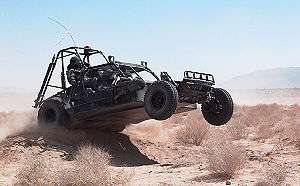Light Strike Vehicle
The Light Strike Vehicle (LSV) is an improved version of the Desert Patrol Vehicle (DPV) it replaced. Although the conventional US military replaced its DPVs with Humvees, special operation groups adopted the LSV for its small size and high mobility. It is part of the family of Internally Transportable Light Strike Vehicles (ITV-LSV).[1] It is used for fast hit-and-run style raids (as its name suggests), scouting missions, special forces support, and low intensity guerrilla warfare.
| Light Strike Vehicle | |
|---|---|
 | |
| Type | Light Attack Vehicle |
| Place of origin | United States |
| Service history | |
| In service | ?–present |
| Wars | War on Terrorism |
| Production history | |
| Designed | ? |
| Manufacturer | Chenowth Racing Products |
| Specifications | |
| Mass | 960 kilograms |
| Length | 4.08 m |
| Width | 2.11 m |
| Height | 2.01 m |
| Crew | 1 driver and 1 gunner + 2 passengers |
Main armament | 1X 12.7 mm M2 .50 caliber HMG, 1 x 5.56 mm M249 SAW LMG, 1 x 7.62 mm M60 or M240 series GPMG |
Secondary armament | 2 x AT4 light Anti-Tank Weapons, or 1 x TOW |
| Engine | Diesel ? |
| Power/weight | ? |
| Suspension | ? |
Operational range | 500 km |
| Maximum speed | 130 km/h on-road; 110 km/h off-road. |
Design
Countermeasures
The LSV is entirely unarmored, and thus offers no protection from small arms fire. The driver and passengers sit side by side in front, with the gunner sitting in an elevated rear-central seat in front of the engine. The gunner's seat can spin around to operate the 7.62 mm GPMG.
Mobility
It can be air transported internally by CH-47 or CH-53 transport helicopters. The new ALSV has a more conventional appearance and differs from the original versions.
Users

Unlike the DPV, the LSV has had export success and is marketed as a light attack vehicle. The current generation model is the ALSV, with the "A" standing for "advanced".[2] It is currently used by the United States Marine Corps, United States Army, United States Navy, and the armed forces of Greece, Mexico, Oman, Portugal, and Spain. The UK retired its LSVs in the mid-1990s.
Current operators
Former operators
See also
- Chenowth Advanced Light Strike Vehicle
- FMC XR311
- List of land vehicles of the U.S. armed forces
- List of U.S. military vehicles by model number, (M1040 and M1041)
- Willys FAMAE Corvo
- Saker LSV
References
- Light Strike Vehicle
- Advanced Light Strike Vehicle overview Archived 2011-05-25 at the Wayback Machine
- Jane's Special Forces Recognition Guide.
- Light Strike Vehicle at GlobalSecurity.org